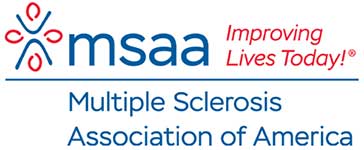Research News
Recent News and Study Updates in MS Research
By Tom Garry
Reviewed by Dr. Barry A. Hendin, MSAA Chief Medical Officer
FDA designates tolebrutinib as a Breakthrough Therapy
In December 2024, the Food and Drug Administration (FDA) granted Breakthrough Therapy designation to tolebrutinib, an investigational, oral medication being studied for the treatment of non-relapsing secondary-progressive multiple sclerosis (nrSPMS).1 The FDA designation is designed to expedite the development and review of medicines that target serious or life-threatening conditions.
While more than 20 disease-modifying therapies (DMTs) are approved for use in various forms of relapsing MS, none are specifically approved for nrSPMS, a condition in which people initially diagnosed with relapsing-remitting MS (RRMS) experience a steady progression without relapses. The Breakthrough Therapy designation was based on positive results from the Phase III HERCULES study involving more than 1,100 people with nrSPMS. The study found that tolebrutinib delayed the time to the onset of six-month confirmed disability progression (CDP) by 31% compared to placebo. Further, 10% of study participants receiving tolebrutinib experienced confirmed disability improvement, compared to 5% of those receiving placebo.
Tolebrutinib belongs to a class of medications known as Bruton’s tyrosine kinase (BTK) inhibitors. For more information on how BTK inhibitors work, please see our “Ask the Doctor” column.
Shorter Transition Beneficial when Switching from Tysabri® to an anti-CD20 therapy
When switching from Tysabri® (natalizumab) to an anti-CD20 monoclonal antibody such as Ocrevus® (ocrelizumab), Kesimpta® (ofatumumab), or Briumvi® (ublituximab), a shorter transition period appears to offer a reduced risk of relapse compared to a longer transition, according to a European study.2
The study involved 139 people with relapsing forms of multiple sclerosis receiving care at one of eight MS centers in Austria, Switzerland, and Germany. All study participants had received Tysabri or a biosimilar version of the medication for a median time of 4.4 years. During one year of follow-up, 16.1% of patients who had a transition period of 45 days or more experienced a relapse. By contrast, 11.1% of those whose transition lasted 30 to 44 days had a relapse, and no patients who made the switch in less than 30 days experienced a relapse.
Tysabri and the various anti-CD20 monoclonal antibodies are considered high-efficacy disease-modifying therapies (DMTs). Since 2017, when Ocrevus became the first anti-CD20 therapy approved for use in MS in the United States, many clinicians have sought to shift their patients with MS from Tysabri to another high-potency DMT because of concerns about progressive multifocal leukoencephalopathy (PML), a rare but often fatal opportunistic infection of the brain.
While cases of PML have occurred in patients taking anti-CD20 therapy as well as in those receiving Tysabri, the duration of Tysabri use has been identified as a risk factor for the condition, prompting many clinicians to try to limit their patients’ time on the medication.
FDA issues anaphylaxis warning for Copaxone® and Glatopa®
Earlier this year, the FDA issued a warning about the risk of anaphylaxis, a rare but serious allergic reaction, with use of the disease-modifying therapy (DMT) glatiramer acetate.3 This medication is marketed as Copaxone® and Glatopa®. The reaction can occur at any time while on treatment, ranging from after the first dose to after doses administered years later. For most patients, the symptoms appeared within one hour of injection.
Although hundreds of thousands of people with relapsing forms of MS have used glatiramer acetate since its approval in 1996, anaphylaxis associated with this medication has only been reported in 82 patients worldwide. While this number is extremely low, individuals taking this medication should be aware of this potential danger and watch for signs of an allergic reaction.
Symptoms of anaphylaxis include wheezing, difficulty breathing, swelling of the face, lips, or throat, and hives. The FDA notes that the early symptoms of anaphylaxis can be similar to a temporary reaction that sometimes happens within minutes after an injection of glatiramer acetate. Involving symptoms such as flushing, chest pain, palpitations, anxiety, shortness of breath, rash, or hives, this post-injection reaction usually goes away on its own within 15-30 minutes.
Readers are advised to contact their prescribing doctor if they experience any of these immediate post-injection reactions, and not to take any additional doses until getting permission from their doctor. If symptoms worsen or do not improve, individuals should seek immediate medical attention by going to an emergency room or calling 911.
References
- Sanofi-Aventis Groupe. Tolebrutinib designated Break-through Therapy by the FDA for non-relapsing secondary progressive multiple sclerosis. December 13, 2024.
- Bsteh G, Hoepner R, Gernert JA, et al. Switching from natalizumab to antiCD20 monoclonal antibodies: Short transition interval is associated with improved outcome. Eur J Neurol. 2025 Jan;32(1):e16587. doi: 10.1111/ene.16587.
- Food and Drug Administration. FDA Drug Safety Communication. FDA adds Boxed Warning about a rare but serious allergic reaction called anaphylaxis with the multiple sclerosis medicine glatiramer acetate (Copaxone, Glatopa). January 22, 2025.
Back
